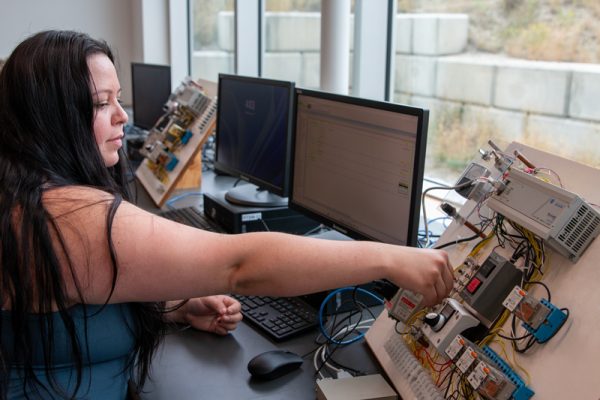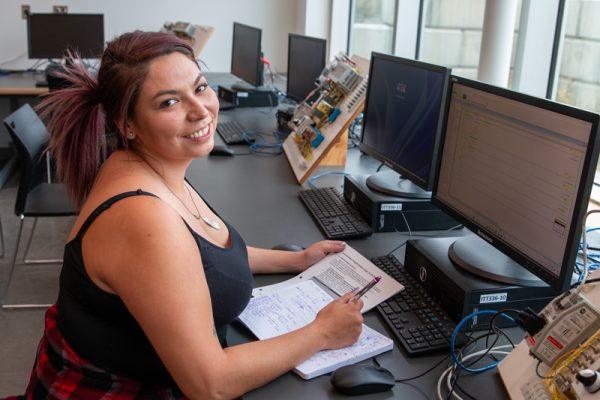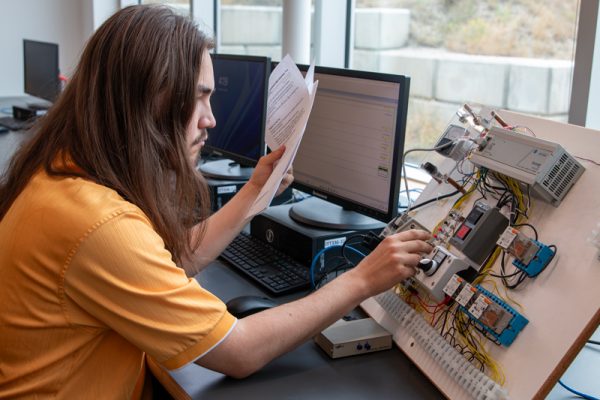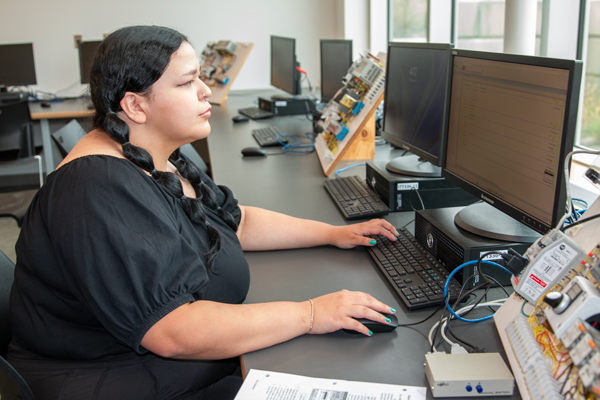A multitude of lakes and waterways are a key feature of the Bulkley-Nechako around Burns Lake, BC, yet access to clean water is a perennial problem. Through a unique online trades program offered for the first time by Thompson Rivers University (TRU), students from several First Nations in the region are on a path to give back to their communities as much-needed water treatment operators.
TRU Open Learning’s Water Treatment Operations Certificate is the first online, self-paced version of the on-campus program offered through TRU’s School of Trades and Technology, tailored for remote Indigenous communities. Open Learning partnered with the Burns Lake Native Development Corporation, a not-for-profit representing six First Nations in the region, which funded the students and hosted the classes. Starting in April 2023, Open Learning Faculty Members delivered the courses virtually to 13 students in Burns Lake, and the program wrapped up last month with two weeks of hands-on labs in Kamloops.
For four students who completed the certificate and have chosen to continue in the on-campus diploma program this fall, the chance to study, work and make a difference in their home communities is everything.
Online classes a game changer

Clarissa Godard from Lake Babine Nation operates an instrumentation panel during hands-on labs at the School of Trades and Technology.
“Being able to access the program from home was great. I don’t think I would have done it if I wasn’t able to access it from home. Having to do that for two years would have been a no-go for me,” says Clarissa Godard.
She and her cousin Jamie Hurd are Lake Babine Nation from Tachet Reserve, about 90 km north of Burns Lake. Tachet is one of two Lake Babine First Nation communities that were part of a national lawsuit resulting in the First Nations Drinking Water Settlement in 2021, which committed funds for the construction, operation and maintenance of infrastructure to provide regular access to safe drinking water in First Nations homes. The Tachet water treatment plant is one of several facilities now providing clean water in the region.
“Being able to make a difference would mean a lot,” says Godard. “Jamie and I worked at the water treatment plant in Tachet for a little while to familiarize ourselves with the place. I joined this program specifically because I know they are looking for new staff to train, so that the current operator can pass down all her knowledge before the time comes for her to retire.”
Destiney Michelle found out about the program on social media just as her pipeline work-camp job was coming to an end, and she was looking for ways to earn a good living close to home.

Destiney Michelle looks forward to returning to Skin Tyee Nation as a much-needed water operator.
“I wanted a job where I could be five minutes from home and still sustain my financial stability,” says Michelle, who is part of the Frog Clan and a member of the Skin Tyee Nation on the south shore of François Lake. She knew her community’s water treatment plant urgently needs operators.
“Our water operators have been wanting to retire for the last few years now, but they haven’t been able to because there’s nobody able to run our water plants. If it wasn’t for the operators, no one in my area, including three Nations and the farmers that also rely on our water source, would have sustainable, clean water.”
Sean Habsburg is from the Luksilyoo (Caribou Clan) of the Stellat’en First Nation, about 65 km east of Burns Lake on the west side of Fraser Lake. He was working as a restaurant server in Vanderhoof when his father alerted him to the program and he saw a chance to participate in his community.
“For a long time, the water quality on the reserve I come from, Stellako, was not acceptable whatsoever. Before 2008, there were high levels of manganese and arsenic in the water,” says Habsburg, noting the Stellat’en were also part of the Drinking Water Settlement.

Being able to contribute to his community, Stellat’en First Nation, is what motivates Sean Habsburg to complete the Water and Wastewater Technology diploma.
“Very recently, there was a station installed and so the water quality has improved. But there’s not a lot of communication between the people who are able to treat the water and the people who are drinking the water. There’s a lot of misconceptions … a lot of complaints. Unfortunately, the operators are very overwhelmed right now, so it’s not easy for them to be able to communicate.”
Preparing for a year away
The last two weeks of labs at the School of Trades and Technology and the Kamloops Centre for Water Quality have provided a taste of life in the city. For these four staying on campus for the Diploma in Water and Wastewater Technology, the transition is challenging.
Habsburg has never lived outside of the north before. “I’m going to a university now which is basically 10 times the size of my community so there’s going to be a bit of anxiety, but there’s also a part of me which is a lot stronger that is very excited.”

Jamie Hurd from Lake Babine Nation is excited to experience campus life with roommates Godard and Michelle as they begin the diploma.
Hurd says she was less nervous about coming to Kamloops because the exams held in Burns Lake provided an opportunity to get to know the others beforehand. After two weeks at TRU, she’s finding her footing and has arranged shared campus housing with Godard and Michelle in September.
“It’s really nice to see everybody face-to-face and hands-on is really nice, too. I feel like I learn more that way. I’ve been a little more outgoing with the other students, I’ve gotten to know them a lot more and feel like we’ll be good friends in the long run,” Hurd says.
The Burns Lake cohort joins 18 on-campus students for year two in September, focused on graduation in April 2025 and the chance to fill the need for more operators all over their region.
“For me, I’ve been part of the potlatch system since I was a baby,” says Habsburg. “Whenever I go to witness a potlatch, they give out gifts and I’ve received those gifts. I’m 22 now and I want to do something. It’s that sense of responsibility and duty. It feels like I’m finally able to give back a little bit.”
“I love my community, I love my Nation, I love my people and I want to help them,” says Michelle.
“We live in isolated communities, so we all help each other out. It drew me even more strongly to do this program, and for us to get to do it from home, not having to move down to Kamloops for the first year was a remarkable opportunity. It really opened my eyes to know I could go back to school and remain in my community for the first year, and after completing my second year, I can return home and provide them with a service that will be continuous. Water will be forever needed, as water is life to all.”
The Burns Lake Native Development Corporation (BLNDC) is a non-profit organization representing members from six First Nations in the Burns Lake area. Water Treatment Operations is one of many programs the BLNDC has provided to support its members with training and opportunities to attain their goals. The BLNDC continues to work with the Water Treatment Operations students to support their success.

